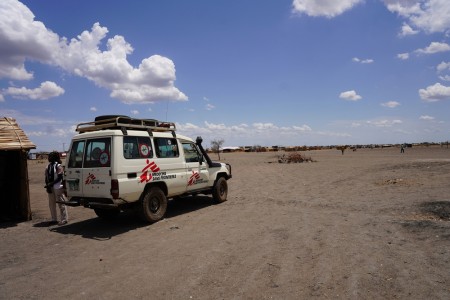
The patient-centered approach: We need an independent Ombudsman
Fabrice Weissman
Based on a reflection regarding how patient rights have changed, in France in particular, Fabrice Weissman discusses humanitarian medicine’s shortcomings in that regard and proposes several avenues for improvement at MSF. This text was originally posted on MSF’s associative website, The Souk.
In a growing number of countries, the relationship between patients and health care providers is governed by laws giving greater importance to individual and collective patient rightsThat change is illustrated, in France, by the 2002 endorsment of the so-called “Kouchner law”, which extended a trend that began in the 1950s with the circulaire on “making hospitals more humane” (“circulaire relative à l’humanisation des hôpitaux”, which put an end to hospital wards) and continued in the 1970s with the first “hospitalized patients’ charter”.. Those rights prioritize patient information, shared decision-making (between doctor and patient), and appeals – and, where appropriate, redress – mechanisms in case of medical accident or malpractice. In addition to those individual rights, new regulations have given collective rights to users, increasingly involved in the definition and management of health policies. In France, in the name of “health democracy”, patient representatives are invited to serve on health care facility governing boardsPublic hospital boards of directors and user committees charged, in every public or private health care facility, with “ensuring that the rights of users are respected and helping improve the quality of accommodations and care for patients and their loved ones”, etc.or health policy regulatory bodiesThe Conférence Nationale de Santé (CNS), the Conseils Territoriaux de Santé (CTS), the Commissions de Conciliation et d’Indemnisation (arbitration and compensation boards), the Comité de Lutte Contre la Douleur (pain control committee), and the Centres de Coordination de la Lutte Contre le VIH (HIV control coordination centers), to name just a few.. In Europe, such individual and collective rights are often accompanied by financial and social rights such as replacement income in case of work disability, total or partial financing of medical care, and other medical and social benefits necessitated by illness (home help, transportation, etc.).
An attempt to rebalance the inherently asymmetrical relationship between health care professionals and users, the fight for individual and collective patient rights has grown out of a number of social and political trends: the erosion of public trust in health care institutions after several health care-related scandals (in France: the contaminated blood products scandal, the “Clinique du Sport” scandal, the growth hormone scandal, and more recently, the Mediator scandal); a rejection of the paternalistic doctor figure who decrees what is good for “his patients”; the incorporation of the ideal of personal autonomy and the liberal social contract to the medical field; broader access to medical information (e.g. via the internet, forums, and popular health magazines); etc. Many researchers consider the AIDS epidemic a powerful catalyst for these changes. The initial impotence of the doctors gave rise to a new generation of patient organizations challenging the “medical establishment”, promoting self-help, confronting pharmaceutical companies and doctors about clinical trial design, defining best practices, demanding that authorities reorient research and prevention policies and provide special social benefits for AIDS patients (e.g., access to loans and sick leave), etc.
More broadly, the growing prevalence of chronic diseases contributed to change the relationship between patients and health care providers. Treating chronic illnesses (HIV, diabetes, hypertension, and heart failure, for example) requires active patient collaboration. Patients have to understand their illness, “adhere to” a demanding treatment, and organize their daily lives accordingly. This requires a whole series of adjustments and behavior changes that health care providers cannot enforce, and that they will have more luck obtaining if they consider the patients’ perspective, expectations, and constraints – in short, if they negotiate the treatment goals and modalities with the patients themselves. In this respect, considering the patient’s perspective is primarily a therapeutic necessity rather than just an ethical obligation.
The rise of patient rights is, admittedly, not without its downsides. It can place too much emphasis on patient autonomy and rights, thereby shifting the responsibility for treatment choices, the illness itself, and potential treatment failure to the patient. On the practical level, implementing the new normative framework may only mean more red tape with no other purpose than officially proving, on paper, that the patient’s rights are being respected – even if that isn’t, or almost isn’t, the case. In France, this normative change has gone hand-in-hand with a policy of cost reduction and a new neoliberal management culture at hospitals. As for “health democracy,” it runs into problems regarding choice, representativity, and the independence of user representatives, and limitations in their actual power in the space set aside for them.
Many health professionals and patient organizations, however, feel the patient rights movement has contributed to more humane and effective medical practices, both clinically and public health-wise.
Yet humanitarian medicine has, on the whole, avoided these normative changes. In terms of collective rights, MSF patients rarely have the opportunity to help define and implement health care projects that concern them. Our actions are at best negotiated directly with the authorities, without consulting users, who also have no role in managing health facilities or designing and evaluating projects. The large-scale (almost veterinary style) medicine practiced at most of our facilities mostly ignores individual patient rights – in particular, the right to clear, accurate information about their disease and to “co-deciding” the treatment objectives and modalities. Rare are the projects that can claim to offer the best available treatments, the best pain relief (especially for children), or decent palliative or end-of-life care. Inpatient and outpatient facilities are often overcrowded, lack privacy, and are marked by precarity and gruff behavior. Our patients find it hard to air their grievances and are still the poor relations in the fight against abuse of power by our staff. Lastly, in terms of social rights, situations in which patients receive social support to facilitate their access to care and treatment and/or mitigate the impact of their disease on their daily lives (disability, social isolation, etc.) are rare. Many patients stop or renounce to seek treatment due to a lack of social or financial support.
There are, of course, many exceptions. Concerned about the risks of non-adherence and the emergence of drug resistance, our AIDS projects have invested heavily in patient education and individual patient support. MSF has, on occasion, encouraged the creation of mutual aid groups (to look for drugs and help struggling patients) and advocated alongside patient organizations fighting the government and pharmaceutical companies for affordable antiretrovirals. In the area of acute malnutrition, in the early 2000s MSF was part of a dual revolution: a technical one, with the large-scale use of ready-to-use therapeutic foods, and a social one, in which mothers were trained to treat their children at home using the new medical products. In both cases – i.e., AIDS and malnutrition – informing patients and their families and involving them in the treatment has made major treatment and public health successes possible. It also, incidentally, helped mitigate the lack of medical human resources by transferring some of the care duties to patients and their loved ones. There are other, more isolated, examples at many missions, in particular in terms of social assistance (cash transfers), combating abuse, and treatment support, for example.
Taking stock of these experiences but measuring the gulf that still separates our practices from existing norms in countries that recognize patient rights, MSF’s Medical and Operations departments have been trying to promote a “patient-centered approach” for several years. In 2021, the Operations Department recruited a “Patient-Centered Care” project manager charged with helping the teams implement concrete efforts aimed at developing a more humane, comprehensive approach to care that treats the patient as a partner (individual rights); tackling the social and financial obstacles that prevent our patients from accessing care or following their treatment (social rights); and, lastly, allowing patients and their entourage to participate in project management (collective rights).
Yet, there are many obstacles to turning intention into action. One, and not the least, is the challenge to move away from traditional medical habits and cultures without pressure from organized patient groups, which have encouraged, if not forced, European and North American health care professionals to change their practices.
How do we overcome these obstacles? First, by redefining MSF’s objectives in terms of patient (or user) rights, spelling out, in the form of a charter, our commitments in three areas: the therapeutic relationship (individual rights); social and financial support (social rights); and political inclusion (collective rights). That is what the “Patient-Centered Care” team is working on now.
Second, by creating one or more “patient rights advocate” position(s) independent of the Medical and Operations departments (and perhaps the operational centers). That advocate (or Ombudsman who could be appointed by the International Board of MSF) would have three missions:
1. To conduct audit missions, on his or her own initiative, aimed at measuring any discrepancies with the standard set forth in the patient charter. Explain those discrepancies. A discrepancy is not necessarily a scandal. It might be explained by particular situation- or context-specific challenges. But it has to be measured, documented, analyzed, and – if possible – corrected.
2. To lead an “appeals and arbitration committee” that users (patients or their families and friends) and MSF staff can go to when they believe that patients’ rights are being violated. That committee would be responsible for conducting investigations and rendering non-binding, but public, opinions.
3. To advise the Operations department. “Lessons learned”: describe and analyze the institutional and practical mechanisms in place at the various field projects – their strengths and weaknesses – and share those experiences; help the Operations department get closer to the norms.
Third, we should release an annual report on patient rights, measuring the progress and setbacks in achieving our commitments toward patients.
The “patient rights” approach is fraught with hurdles: first, defining a normative framework detailed enough to be auditable and flexible enough to be applicable to a wide range of environments; and second, determining who are legitimate patient and user representatives. Nevertheless, it is a potentially powerful lever for changing practices and reaching one more milestone in providing high quality humanitarian medicine. As the main forum for mutual accountability, the MSF International Board should play a leading role in this regard.
To cite this content :
Fabrice Weissman, “The patient-centered approach: We need an independent Ombudsman”, 1 juin 2023, URL : https://msf-crash.org/en/blog/medicine-and-public-health/patient-centered-approach-we-need-independent-ombudsman
If you would like to comment on this article, you can find us on social media or contact us here:
Contribute




Add new comment